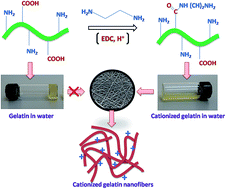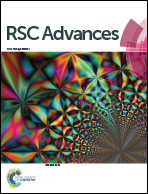Fabrication of cationized gelatin nanofibers by electrospinning for tissue regeneration†
Abstract
Gelatin based electrospun nanofibers are promising candidates for tissue engineering and regenerative medicine due to properties like biocompatibility, non antigenicity, non-toxicity and structural resemblance with native extracellular matrix. In the present work, a new nanofibrous scaffold using amine functionalized gelatin is fabricated. Modified gelatin is also known by the name cationized gelatin as the amino group is getting protonated. Unlike gelatin, the cationized gelatin is soluble in water without forming gel at room temperature. Hence, electrospinning of cationized gelatin can be carried out using water as the solvent. The water stability of cationized gelatin nanofibers is improved by cross-linking with two novel cross-linking agents, namely a disaccharide (sucrose) and a polysaccharide (dextran). The resulting cationized gelatin nanofibers are evaluated for the mouse fibroblast and human osteoblast like cells attachment, adhesion and proliferation. The results demonstrate that the electrospun cationized gelatin nanofibers can be potential scaffold materials for tissue regenerations.


 Please wait while we load your content...
Please wait while we load your content...